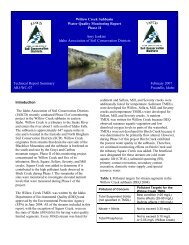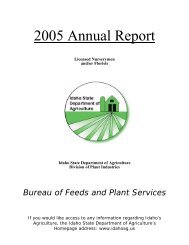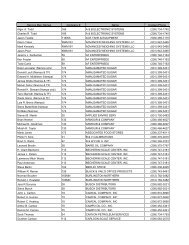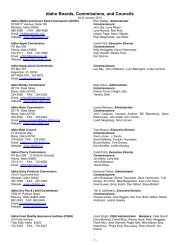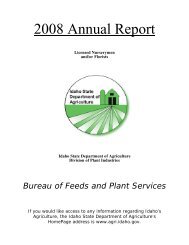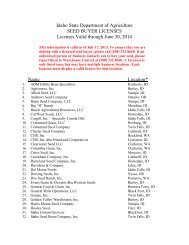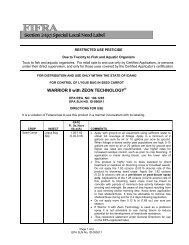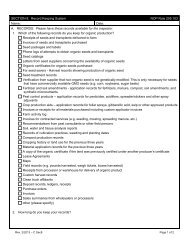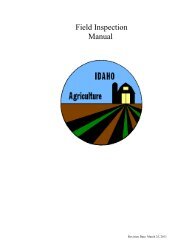2008 Statewide Strategic Plan for Eurasian Watermilfoil in Idaho
2008 Statewide Strategic Plan for Eurasian Watermilfoil in Idaho
2008 Statewide Strategic Plan for Eurasian Watermilfoil in Idaho
Create successful ePaper yourself
Turn your PDF publications into a flip-book with our unique Google optimized e-Paper software.
Recommendation 3.1: Herbicide residue analysis<br />
• M<strong>in</strong>imize the number of samples required to be analyzed that will be collected from<br />
treatment sites to those necessary to document contract per<strong>for</strong>mance or to ensure<br />
adherence to required residue levels.<br />
• Dur<strong>in</strong>g the 2006 program, the <strong>Idaho</strong> Department of Environmental Quality required that<br />
residue samples be analyzed from some herbicide applications beyond those required by<br />
the herbicide labels. These data should be compiled and evaluated to determ<strong>in</strong>e if this<br />
policy needs to be cont<strong>in</strong>ued, and if so, how the number of samples can be reduced<br />
significantly.<br />
• Residue analytical costs can be greatly reduced by ISDA plac<strong>in</strong>g out to bid annual<br />
contracts <strong>for</strong> herbicide residue analyses from all the state contractors. This will save<br />
contractors time and the higher number of samples <strong>in</strong> one per<strong>for</strong>m<strong>in</strong>g laboratory may<br />
reduce per sample costs.<br />
ISDA Response: ISDA will work with DEQ to review these requirements and provide clear<br />
recommendations on the number of samples that are required. Additionally, the Aquatic<br />
<strong>Plan</strong>ts Program Manager will explore the possibility <strong>for</strong> annual contracts <strong>for</strong> herbicide residue<br />
analysis to reduce per sample costs.<br />
Issue 3.2: Use of adjuvants<br />
While there is no doubt that surfactants/adjuvants are important <strong>in</strong> foliar applications of<br />
herbicides, there is little data to support use of adjuvants to improve efficacy aga<strong>in</strong>st<br />
submersed aquatic weeds. Granular <strong>for</strong>mulations and fluridone liquid most likely do not<br />
benefit from the addition of adjuvants due to the release rates of granules and the mode of<br />
action of fluridone. The only possible benefits of the addition of adjuvants may be <strong>for</strong> liquid<br />
herbicides that are absorbed rapidly, such as 2,4-D am<strong>in</strong>e, diquat and endothall. Data<br />
support<strong>in</strong>g this premise are not available, despite the fact that some applicators are conv<strong>in</strong>ced<br />
that improved efficacy results from addition of surfactants <strong>for</strong> herbicide absorption and s<strong>in</strong>k<strong>in</strong>g<br />
agents <strong>for</strong> herbicide placement<br />
There is concern by some state agencies that certa<strong>in</strong> surfactants may be toxic to zooplankton<br />
and other <strong>in</strong>vertebrates. Comb<strong>in</strong>e this with the fact that EPA does not regulate nor register<br />
surfactants makes regulatory agencies hesitant to allow their use. Wash<strong>in</strong>gton State has<br />
developed a list of approved adjuvants which seems to be a reasonable approach until<br />
additional studies or data are collected which would either a) show toxicity or lack thereof of<br />
surfactants to <strong>in</strong>vertebrates or b) def<strong>in</strong>itive data are provided which clearly shows significantly<br />
improved efficacy of the addition of adjuvants to herbicides used <strong>for</strong> submersed weed control.<br />
Adjuvants used <strong>in</strong> this context <strong>in</strong>cludes surfactants, foams, s<strong>in</strong>k<strong>in</strong>g agents or other chemical<br />
spray additives<br />
.<br />
Recommendation 3.2:<br />
Allow applicators to use approved adjuvants from the Wash<strong>in</strong>gton State list at<br />
http//www.ecy.wa.gov/programs/wq/pesticides/f<strong>in</strong>al.pesticide.permits/registered_pesticides.html.<br />
ISDA Response: ISDA will review lists from other states and may adopt them <strong>for</strong> use <strong>in</strong> <strong>Idaho</strong>.<br />
Issue 4.0: Exemption from state water quality standards by temporary water quality<br />
degradation caused by aquatic weed control activities.<br />
63



